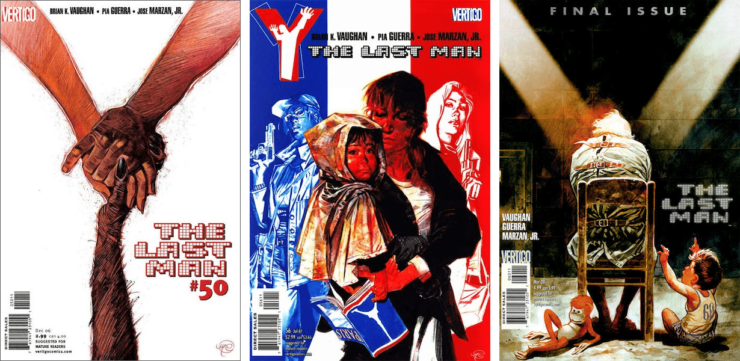Here we are, at the end of Brian K. Vaughan and Pia Guerra’s Y: The Last Man, and unlike the characters in the series or the original readers, it did not take us five years. Still, it’s been a revelatory ten weeks rereading what I believe is still the best of the gender-essentialist dystopias, while simultaneously acknowledging that its premise and execution are imperfect, especially when regarded twenty years later. To that end, I was delighted to revisit the final two trades, which answer the big question about why the XY plague happened (…sort of), and then blast forward to 2066 to examine the ripple effect of those first few post-plague years.
And by delighted, I mean I gasped, I rolled my eyes, I commiserated, and I ugly-cried at a point I completely didn’t expect to. I hope you experienced some of this roller-coaster ride of emotions, and that you’ll join me for our final Y: The Last Man reread.
Volume 9: Motherland
Despite the title of this volume—and the return of the badass female Dr. Matsumori—Motherland is all about fathers. From Yorick’s existential crisis regarding cloning to Allison’s dad having, well, an existential crisis about cloning, the few remaining cis men take a good hard look at what they can actually contribute to the future of humanity or whether they should just step aside with the rest of their chromosomal kin.
Yorick’s Prophetic Dreams: Yorick dreams himself into a hardboiled noir, with a “dollface” in Beth who’s actually speaking pretty close to directly (rather than spouting alternate definitions for bridge): She tries to tell him there’s something wrong with her brain, but the subtext is it’s not you, it’s me. Then it’s cautioning that he won’t live if he tries to find her—a warning about Alter? But what really cements it, though he doesn’t realize yet entirely what it means, is that she calls him ’Rick—355’s nickname for him.
The Bad Touch: I’ve mentioned it before but not given the subject its own focus: Almost all of Yorick’s Beth dreams are rife with sexual innuendo. It fits him, as the snarky English major who won’t shut up while awake, so of course his subconscious would spool out punnery even if the dreams themselves are the opposite of sexy. Yet I’m not entirely sure how we’re supposed to interpret the dreamscape wordplay—is it expressing general sexual frustration? Replaying that aspect of his relationship with Beth because it’s tougher to recall the emotional moments? A commentary on various genres (space opera, fantasy, detective noir) being highly sexualized depending on which perspective is utilizing the tropes? Or maybe it’s just a joke about cis men always thinking about sex.
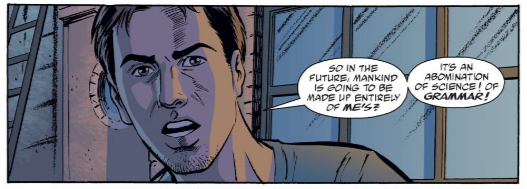
Life, Uh, Finds a Way: After so many issues focusing on the two spontaneous pregnancies that will mark the (admittedly very small) start of the next generation, we finally get to hear about how Allison will bring about the actual next wave of humankind: by cloning Yorick! Well, he’ll be one of roughly 200 gene strands necessary to prevent inbreeding and the like, but he’ll be a father, so to speak, to a lot more people than just Beth Jr. Yorick is understandably freaked out by this global perpetuation of his gene line (and, presumably, everything he hates about himself), and Allison comparing his potential future impact to Genghis Khan is…not entirely helpful, but also probably (hopefully) her trolling him.
And let’s not forget that Yorick and Rose finally coax Ampersand and Bonnie into mating so that their potential future offspring can protect any XY clones.
Buy the Book


Comfort Me With Apples
Mano a Mano: The one time we can use this one literally: Allison’s father, Dr. Matsumori, also survived the plague! And once he administers a morphine drip to shut his daughter up, it’s him and Yorick talking through how much they, as cis men, have failed all of the women in their lives.
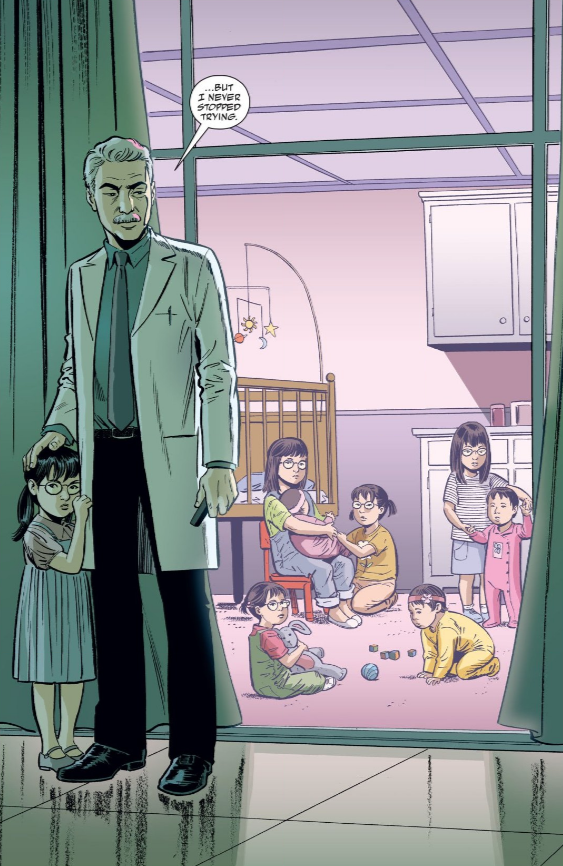
Sins of the Father: We’ve gotten plenty of flashbacks into how Dr. M moving his family, motivated both by emotional affairs and prioritizing his unorthodox work, splintered Allison’s life early on. It would seem that in his old age he has managed some self-reflection…but in, like, a Narcissus kind of way. “From early on, I knew I had failed you as a father, Ayuko,” Dr. M tells either his adult daughter, recovering from a surprise hysterectomy in a hospital bed, or her four-year-old clone. “I’d failed you as a man…but I never stopped trying.” Aaaand cue at least a half-dozen Allison clones, as he has turned his unsuccessful relationship with his daughter into a science experiment.
Plague Narrative: And according to Dr. M, that first clone is what obliterated the XY chromosome. Not only did he sabotage Allison’s clone of herself via Toyota delivering an abortifacent (heartbreakingly mundane and devastating on so many levels), but had impregnated Dr. Ming with an identical Allison clone whose birth seemingly coincided with the shock wave that rendered every XY organism obsolete. Allison’s flashbacks, and conversations with her mom in the prior volumes, have already introduced the concept of morphogenetics, or the idea that evolutionary advances can be passed along through the collective unconsciousness. That is, once a clone was successfully birthed without the need for the XY chromosome, the chromosome finally gave up the ghost and removed itself from humanity.
Best Magic Trick: Yorick talking up his trusty lock-picking pen as the way to escape Dr. M…only for 355 to have swiped it to use on her cuffs in arguably a much more dire situation—facing down a taunting Toyota.
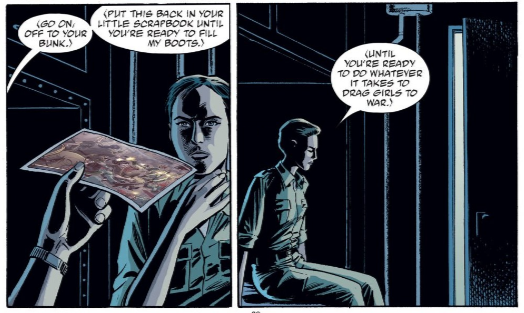
Death Wish: Alter, confronted by her newest adoring second-in-command Eliana about the doctored war photos, puts a gun to her head but doesn’t pull the trigger: “Sorry Sadie, not today.”
Meanwhile, Dr. M has no such compunctions about roping Yorick into a nonconsensual suicide pact! He’s Yorick pre-711 intervention, scared shitless of women and unable to see a place for himself alongside them—or, more likely, unwilling to accept that he can still have a place but it will probably be behind them. So he’s ready to take down Yorick with him—until Allison reveals that of course she unhooked her morphine drip the second her father revealed himself, because she can’t trust his bedside manner for one moment. So, Dr. M gets to die like he wanted—but it’s at the hands of his daughter, in front of his other daughter, oof.
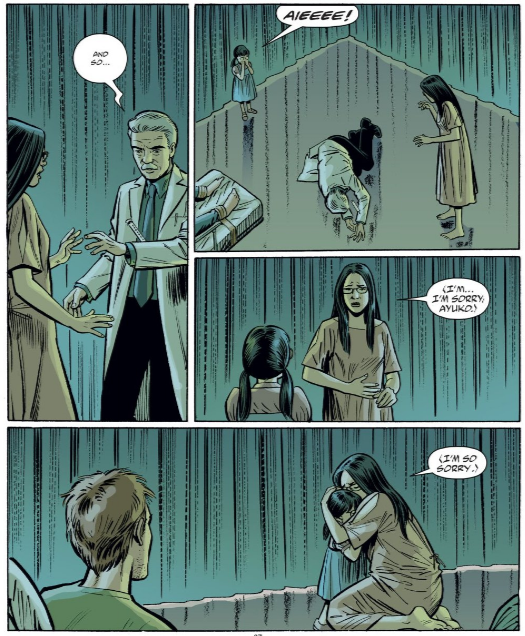
The Gender Issue: “The Obituarist” brings back two memorable characters from earlier issues: Waverly the supermodel-turned-gravedigger and Bobbi the sex worker. The issue reiterates how Bobbi does not regard herself as a trans man, both by mentioning Waverly’s deceased boyfriend (who was trans) and with Bobbi referring to herself as “a fake guy”—the latter does not come off sounding good in a 2021 reread context, but it does seem to fit her arc. For Bobbi, gender has always been a performance that has little to do with her own self-identity and is primarily focused on providing a service to cis women mourning their lost loved ones; that’s part of why she still uses she/her pronouns and often draws attention to her glued-on facial hair and her “almost” real-feeling “equipment.” Rereading from a 2021 context, I did confuse Bobbi as a trans man, forgetting as other characters have that she’s a male impersonator.
Where I was surprised to see Waverly and Bobbi’s story at its thorniest was not about gender but about sex work itself. While most of Bobbi’s appearances involve her negotiating with potential clients out of some desperation, she does also seem to enjoy what she does. Yet Waverly projects onto it that Bobbi is stuck in this toxic cycle of servicing other women—obviously bringing her complicated past as a supermodel, and her quick drop to obsolescence, into her interpretation. Waverly ripping off Bobbi’s beard and lecturing her by saying “you’re better than that” can certainly be read as anti-sex work, especially in today’s context, but I do think it fits these two characters’ particular interaction at this moment in time. Even those who don’t know the latest in Allison Mann’s research are still aware of a changing tide: They’ve gotten through the first nearly half-decade since the plague and survived, they know that they will continue on. I’d like to read Waverly’s challenge to Bobbi as not necessarily saying stop being a sex worker but more if this is what you want to do, own it on your own terms rather than someone else’s.
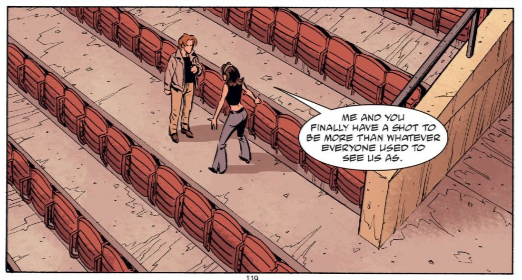
Sisters Are Doing It For Themselves: The two standalones at the end of Motherland give us two final takes on this, at least until the several-generations-later time jump. Waverly seems to be doing great since last we saw her get her garbage truck-turned-corpse carrier jacked by 355 and President Valentine: She’s a legit gravedigger, employing ex-Amazons and other women looking to make a difference as there are still bodies to be given proper burials or cremations. She lives at the Watergate, gets to have romantic dalliances with folks like Bobbi, and even has the unprecedented honor of preparing Jennifer Brown’s body to lie in state—the first female politician afforded such a distinction.
We also get one more encore from the Fish & Bicycle troupe, who have paused their wandering to briefly settle down in Hollywood and make a go at the next phase of the movie industry. It…doesn’t really work. Misunderstood (but also polarizing) Cayce is ahead of her time in basically making Ocean’s 8, but with a sperm bank heist replacing the Met Gala and Amazons instead of James Corden. When the members of the original troupe hit too many creative differences to stay together, Cayce winds up writing something on her own, with remaining collaborator Henrietta creating the art: I Am Woman, a comic about a plague that wipes out…every XX chromosome on the planet, except for one woman and her horse.
Volume 10: Whys and Wherefores
If you’ll permit me one more Anastasia reference: Paree holds the key to your heart… if by key, we mean the harsh truth about Yorick and Beth’s relationship that he’s been working out subconsciously for the past four years, not to mention the very clear vision he had about who he really loves. It’s strangely heartening to see that, five years after they created Y, Vaughan and Guerra delivered on the series’ bleak premise with a brutally realistic ending, even if all this time we wanted to see everyone arrive at an uncomplicated happily-ever-after.
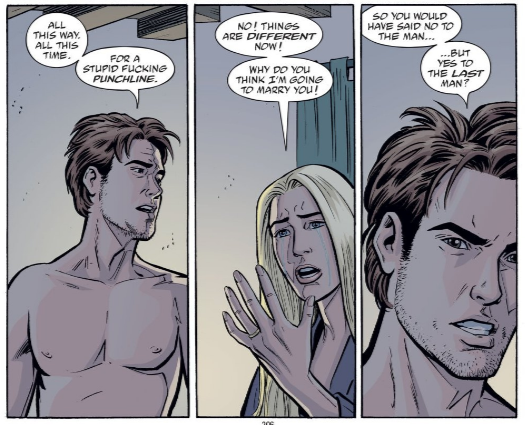
The Bad Touch: No surprise, Beth and Yorick immediately run back to her hotel and tear the place apart. It’s the first time in the series’ present action that we’ve seen sex be entirely uncomplicated and guilt-free for him, even if he bristles at Beth’s joke about “when did you get that good?” (She has a point, Y.) But the afterglow immediately dissipates when Yorick muses about how he’d had all these dreams about Beth telling him not to find her, how funny is that, and she confesses that, nope, he had it right—she was going to break up with him. Aaand now Yorick is always going to associate their triumphant sexual reunion with utter heartbreak. Good luck ever untangling those two, bud.
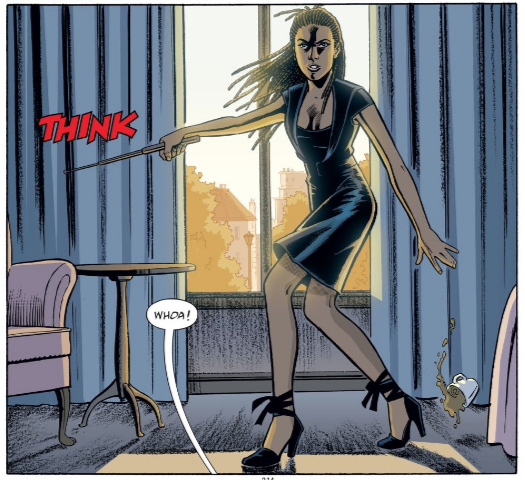
The Gender Issue: After five years of leather jackets and pants she can run and kick ass in, 355 trades in her Culper Ring look for a gorgeous dress…that she can still kick ass in, when Yorick comes to find her after the Beth fight. Though he does tease her about looking like a ballerina. It, plus the gradual growth of her hair over the past 59 issues, is meant to be a visual signifier that she’s casting aside her more masculine persona and embracing a softer, more feminine side. Which is not to say she wasn’t feminine when she was being a badass agent and protector, but I think that’s what the comic was going for here.
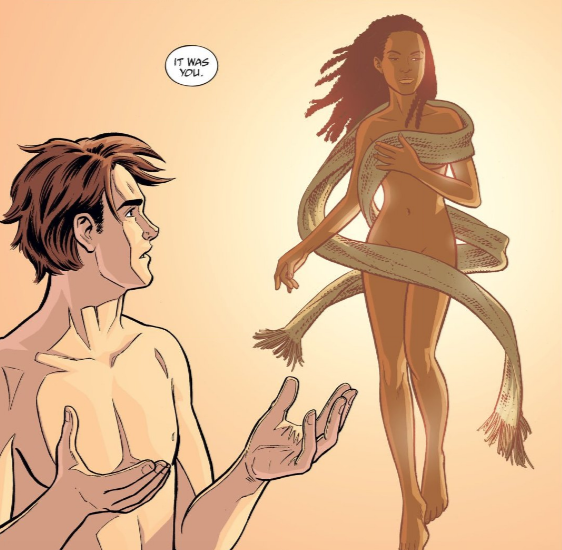
Yorick’s Prophetic Dreams: We finally get to see what vision from Safeword made Yorick want to live—and in contrast to his complicated Beth nightmares with their genre filters and tons of subtext, this is beautifully simple: It’s Agent 355. The only layer to this is her scarf (which it’s unclear if Yorick dreamed at the time or if he retroactively added it after she gifted it to him in Paris), covering her tasteful nudity. (It’s a fascinating contrast to Yorick’s final warning dream earlier in the trade, which involves 355 bare-breasted in BDSM garb before she transforms into rotting-corpse Beth.) Regardless, now we know that it was always 355 who kept him going, not just in physically saving his ass but in convincing him that his life had value.
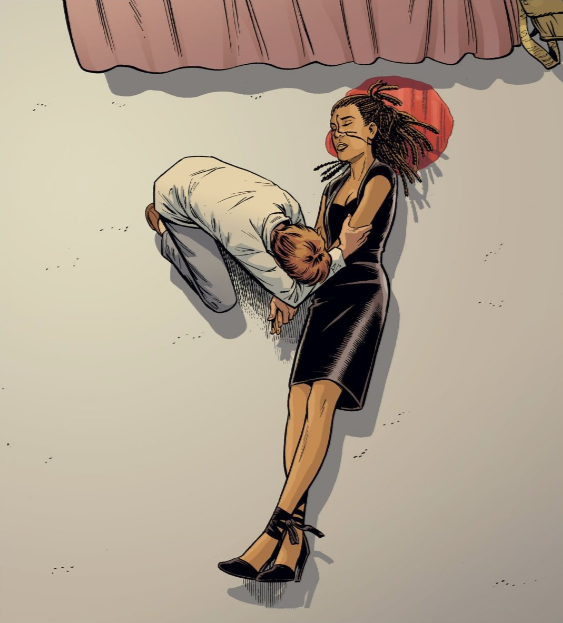
Mano a Mano: Sigh. So of course we follow up this revelation with the head shot. The deceptively simple crack of a hotel room window breached, a pinpoint hole in 355’s forehead, and the loss of one of comics’ best characters. All because of Alter Tse’elon.

Best Magic Trick: Chekhov’s. Gas. Mask. Yorick hasn’t donned this disguise in quite some time, figuring that he was well past the point of fooling anyone, but when Alter descends upon the hotel room to meet death, he’s wearing the mask that protected him from death four years prior, and it’s so fucking perfect.

Death Wish: Though Motherland made it clear that Alter doesn’t want to live in this world for much longer, it’s not until she’s facing off against Yorick that the extent and specificity of her death wish becomes clear: She needs it to be him. She won’t accept defeat from anyone but the last man—she, a woman whose very name reflects her lifelong flight from death. Does she regard Yorick as the personification of death simply because he eluded it? Is sexism so ingrained in her that no female soldier would be “good enough” to kill her? At any rate, Alter will murder Yorick’s mother and his love and mock every memory he has of either one in order to goad him into killing her. So, he won’t give her the satisfaction and instead turns her over to her troops, who seem to be finally disillusioned about the awful lengths their leader will go to not even for world peace, but for her own selfish attempt at closure.
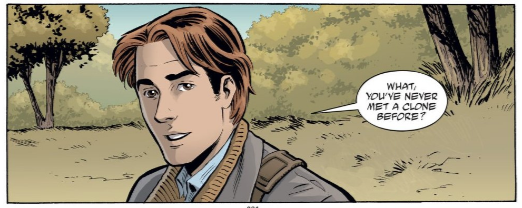
Life, Uh, Finds a Way: Aaaand it’s a sixty-year time jump! Humanity hasn’t destroyed itself and is in fact… thriving? The next several generations have all been cloned from someone who came before, though it sounds as if it’s still been mostly cis women populating the Earth.
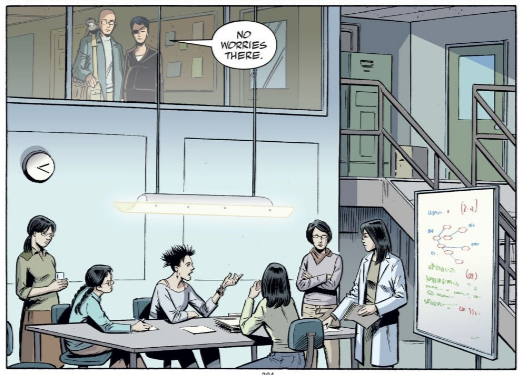
That said, there are at least 17 Yorick Brown clones in existence, though the presence of a cis man is still worth a double- or even triple-take. That’s thanks to the half-dozen clones of Allison Mann, who carried on her work, and willing surrogates like Rose.
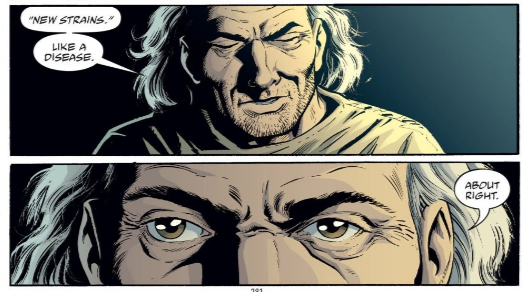
And though Yorick Brown the Seventeenth most resembles the original, he’s not indicative of his entire gene line; the year prior, they finally started engineering new strains, making Yorick into (according to the original) almost a disease. Notably, however, there are no clones of 355 (a.k.a. Peace).
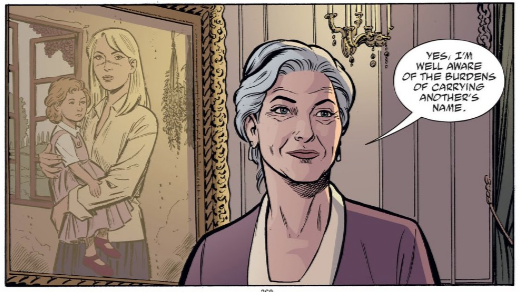
Sisters Are Doing It For Themselves: Beth Jr. is president of France! (Presumably because she and her mom stayed there after the events of the prior issue?) Vlad is the czar of Russia! (But of course.) Beth II and Ciba have set up their kids for the best possible futures—perhaps because they’re the only non-clone births post-plague and that gives them some precedence? (I would have loved to see the final issue delve into what, if any, anti-clone prejudice exists, but there was just no way to do that and wrap up all of our favorite characters’ lives.)
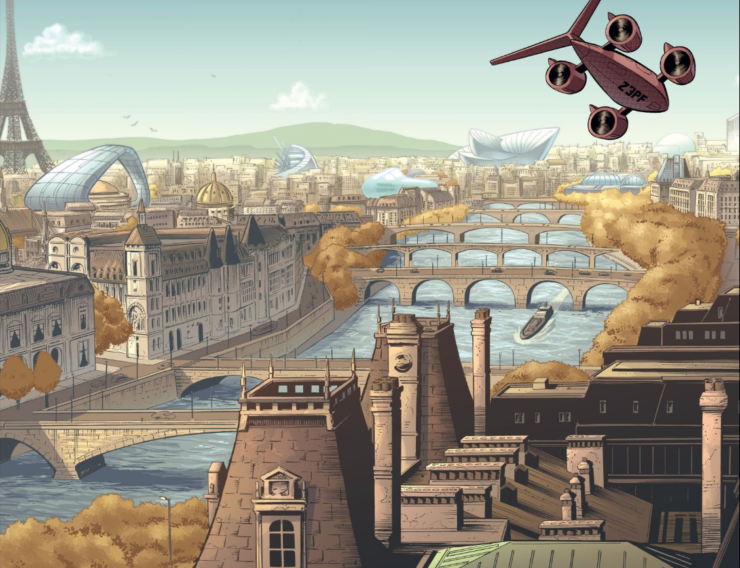
The Culper Ring has also transformed into the Culper Sphere—perhaps the name implies a more holistic/nuanced approach? Obviously it’s become an all-female endeavor, though I’d be curious to see when they start recruiting boys…perhaps they’ll start with Yorick Brown the Seventeenth, depending on if they interpret his “mission” to entertain his great-grand-self a success or a disaster.

Best Magic Trick: Time jump means we can run this category twice, because Yorick deserves kudos for two brilliant tricks over a half-century apart. Beth Jr. brings in the Yorick clone who most resembles her father in the hopes that he might make the 86-year-old Yorick laugh; he had attempted suicide on his birthday, though he jokes that that was a play on being 86’d. Instead, he fills in the blanks of the past 60 years (more for readers’ benefit than for poor confused clone!Yorick) and leaves his descendent with some sage advice: “Just go out there and get your heart broken in, so it’ll be ready when you really need it.” Then, with the help of all the Ampersand clones (in a rare show of their original’s well-meaning asshole behavior), he distracts clone!Yorick long enough to escape out the window, straitjacket and all.
Commentary
Even though I learned this in high school, I didn’t really consider the meaning of Whys and Wherefores until rereading: Anyone who reads Shakespeare’s Romeo and Juliet learns that “wherefore” is another word for “why,” so “wherefore art thou Romeo” isn’t Juliet trying to ascertain location, but rather mourning why did it have to be you, Romeo, of all people. That’s the question Yorick and many others have asked for this entire series, trying to figure out what made him special enough to survive the plague. But the same goes for the sixty years after the events of the series, with the aging last man wondering what possible reason there could be for him losing the woman he had truly come to love. Turns out it’s one and the same: cruel fate guided by the hands of flawed humans.
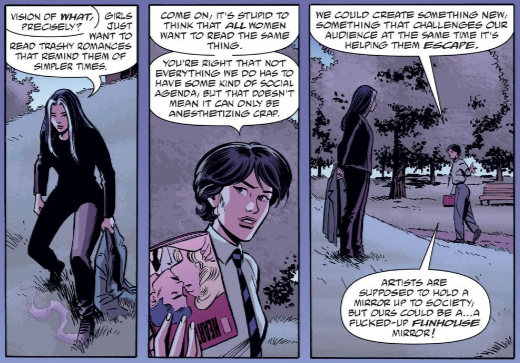
Before I get into the nitty-gritty of the plot, I have to say that I didn’t expect to identify so much with playwright-turned-screenwriter-turned-comic-book-writer Cayce, who goes from trying to collaborate with her fellow artists on live performance (despite her own prickliness and control freak tendencies) to the partnered effort of writing a comic book that best distills the ideas she’s been turning around in her head since the plague struck. Because who among us did not experiment with different mediums during Covid? I turned various plays that weren’t working into a TV pilot and a manuscript, and I guess I’ve finally answered my own question about who I would be in the post-apocalypse: a writer who must go through several unsuccessful projects before finding a way to potentially capture the moment, and then have that art dismissed anyway.
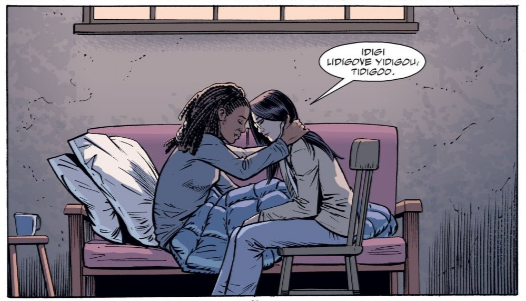
But as I’ve said before, that’s not what propelled the plot to the finale—it was love. While earlier issues of Y somewhat clumsily introduced some manner of attraction or affection between 355 and Yorick, by the time Motherland establishes that 355 is in love with her charge, it makes sense—partly because it’s no-nonsense Allison delivering the diagnosis, while in the same breath she and 355 acknowledge a different but no less important kind of love between them. That dread does suffuse 355 and Yorick’s final days together on the mission, before she delivers him (scarf in hand!) to Beth. That breakup was hard to read the first time, at 22 and a year out from my own college relationship crashing and burning over expectations of a future simply because we had been together long enough that the alternative seemed unfathomable.
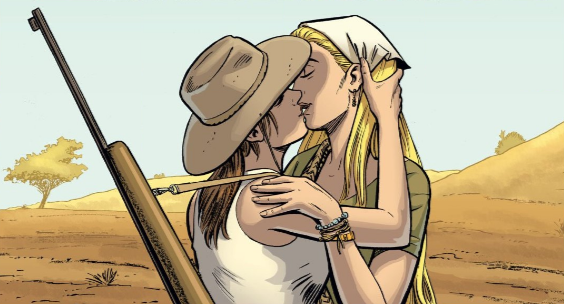
But I’m glad Yorick and Beth figure things out enough, even if it means they’re rarely in the same room together for the rest of their lives; and Beth/Hero was hinted at enough in the preceding issues that it lands a lot better on the reread.
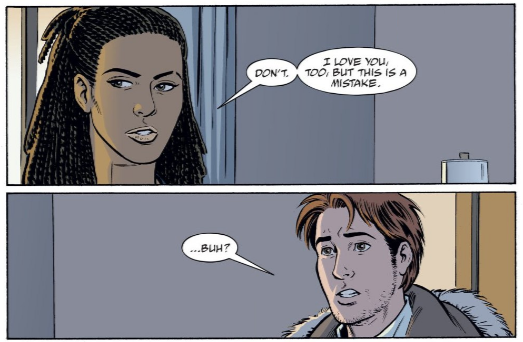
Yet by the time Yorick and 355 finally admit to their feelings, it’s rather anticlimactic. Not because they don’t have sex, but because he still stumbles over even saying that he’s attracted to her, or inserts a Moonlighting reference to clarify his anxiety over changing their relationship from one thing to the other, even though that change has already happened. I still remember where I was when 355 got shot: lying in bed in my apartment in Queens, sobbing like a loon and clutching Whys and Wherefores to my chest. I never could have imagined that this was how their story would end, and it broke my heart. Upon reread, it’s a quieter tragedy, but it helps to remember that where things really end for them is that lovely flashback of them sitting on some plane wreckage, bullshitting.
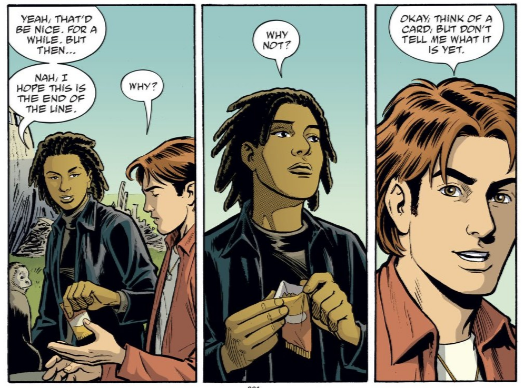
It’s an interesting choice to give Allison and 355 matching hysterectomies in Motherland, ensuring that neither would biologically pass on their genes. 355’s relieved laughter is played as a reversal; her womb had never held much value to her, and she had worried that she was losing something more dear to her. With Allison, the loss is more gutting, yet she doesn’t get as much time to get used to the idea, as it comes with the dual revelations of her mother being the one to take away this ability and her father being alive—and the discovery of her clone siblings.
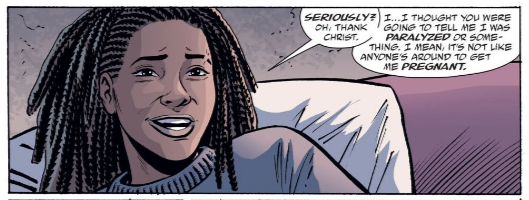
It’s all a stark contrast to the Sisterhood of the Traveling Beths (cannot believe that didn’t occur to me until this final reread), with Ciba and Beth II so fertile that it seems impossible for them not to have gotten pregnant despite the sheer amount of chance that goes into conception.
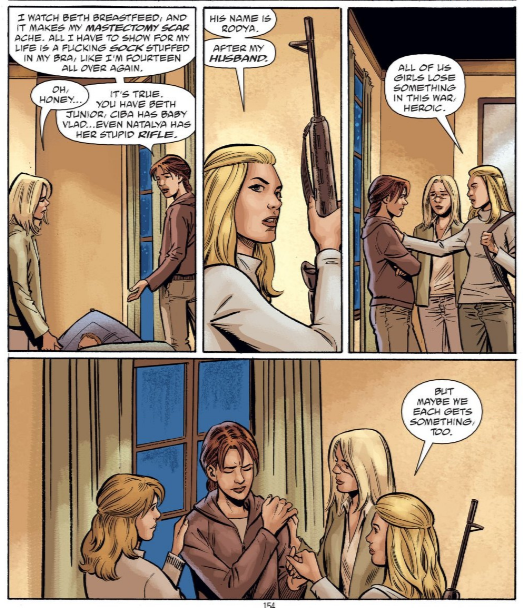
Together they form an ersatz family, their loyalty tested when Natalya is tempted to spirit Ciba and Vlad Jr. to Russia but instead agrees to save the three Beths and Hero from Alter and her soldiers.
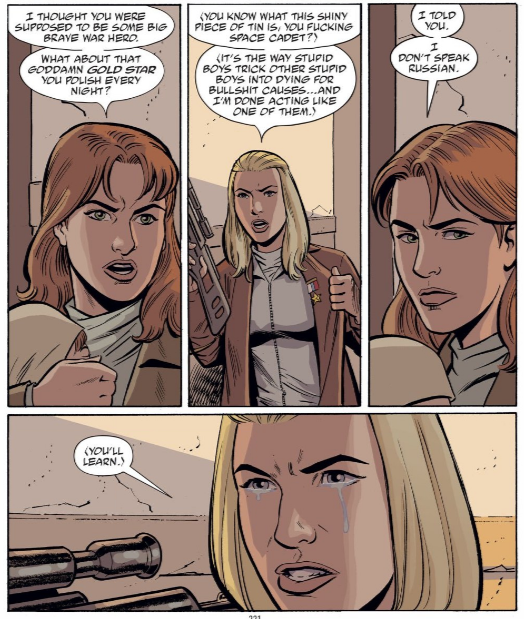
While the two biological offspring of Earth’s remaining few cis men grow up to run the world, it’s the “Dr. Men” who ensure that these future world leaders will have other members of their generation. At least, cis female members—as established above, it takes until nearly the end of the original Yorick’s lifetime for more men to be created. He blames nature versus nurture, believing that Allison’s clones weren’t pushed the same way she was, to need to develop cloning breakthroughs to prove something to an abusive father. Yet those clones didn’t have to suffer the same emotional trauma and identity crises.
I had forgotten that Yorick has the option to clone 355, but it makes perfect sense that he would immediately discount the possibility: It wouldn’t be her. Trying to recreate what he and Peace had after four years together, but without the lived experience for the clone, would be like trying to pick things up with Beth once he knew that they were never meant to be in the first place.
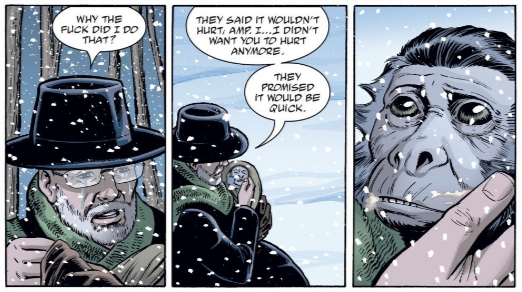
Let me just say, Ampersand’s death hits a whole lot harder when you have an old pet. My dog Cid just turned 11; though his health has overall been fine, he’s definitely more prone to injuries and other concerns these days. A few years ago, my husband and I reached a sort of unspoken agreement that he might not have many years left; we let him start sleeping with us in bed, both valuing the quiet moments with him and each starting to prepare ourselves in small ways for a future without him. Well. Watching Yorick feed Ampersand a medicine-laced grape and apologizing for it hurting—because he didn’t want Amp to hurt anymore—wrecked me more than anything else in this reread. He’s giving Ampersand what he needs to die, after Amp gave him what he needed to live. Fuuuuck.
But we can’t end there. Despite all the death in Y, from the first plague extinction to these bitter losses, the series ends on life. Yorick’s last memory, as he’s escaping his daughter’s opulent prison, is from the start of his journey with 355. He will not be the last Yorick Brown; there is another 22-year-old namesake ready to get his heart broken and bitch about it and hopefully have a better life afterwards. And despite all of his close calls, the series has always promised us: We will not see the last (cis) man die, only finally shrug off the straitjacket and disappear for good.
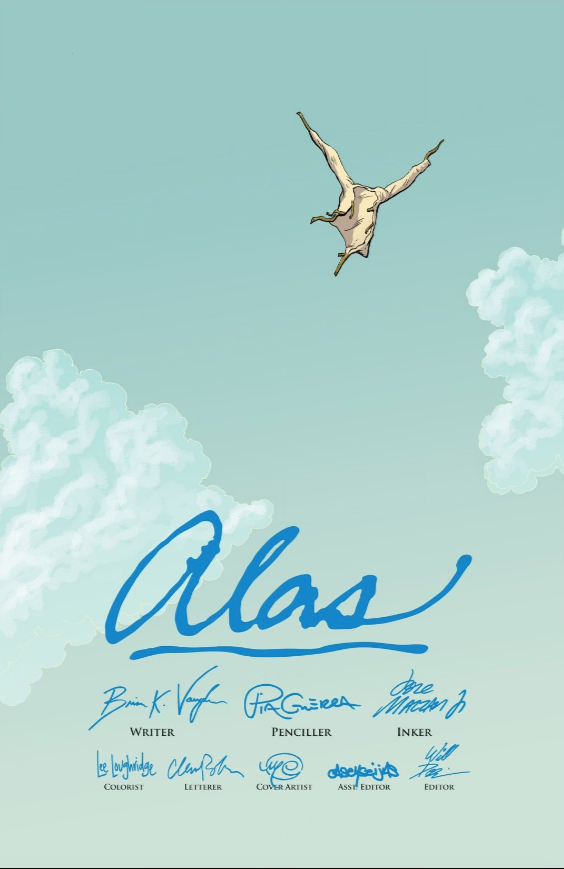
Somehow it is very fitting to pivot from that final “ALAS” to a new NOW: The Y: The Last Man TV adaptation premieres on FX on Hulu today! The first three episodes drop at once, and you’ll be able to read our review very soon. Thanks for joining on this reread, and looking forward to what you love/hate/are surprised by in the next iteration of Yorick Brown’s story.
Natalie Zutter isn’t crying because it’s over, she’s smiling because it happened. (No, she’s still crying over Amp’s death.) Join her here and on Twitter for the next eight weeks watching Y: The Last Man!










